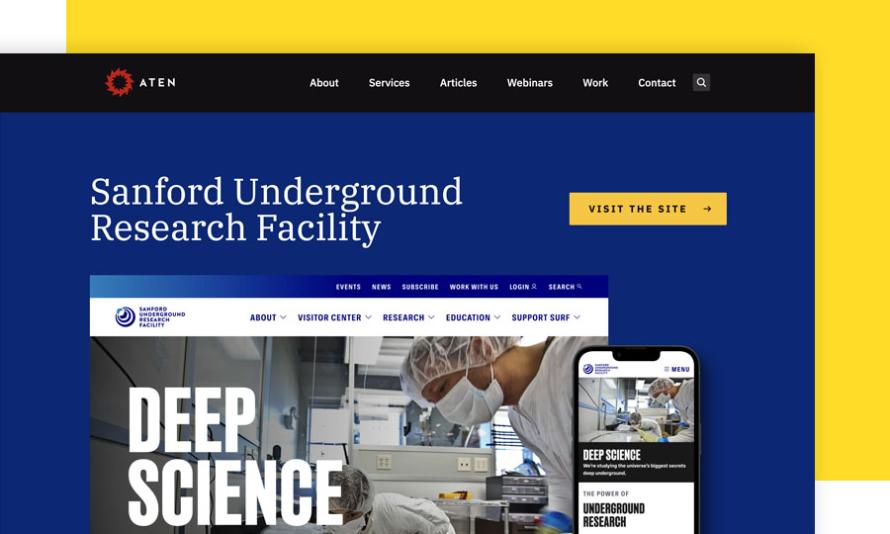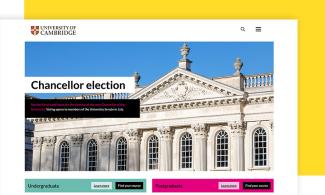Filters
Content Type
Topics
America’s Underground Lab: a Research Website Creation Story
Sanford Underground Research Facility (SURF) in Lead, South Dakota faced a NASA-level challenge. With most visitors unable to experience its underground facilities, its website had to bridge the gap, providing a virtual gateway to the world of deep science. The task wasn’t just to inform – it was to simulate the experience of visiting an extraordinary, restricted environment.
Known as America’s Underground Lab, the facility is the deepest laboratory in the country housing research in physics, biology, geology and engineering with a robust education and outreach program. “The job of our website is to share what we do underground. It’s no secret, but you can’t just jump in a cage and go down to see what’s happening. The site is very important for fundraising, policy-making and education,” said Matthew Kapust, Multimedia Design Lead at SURF.
Before: Web Challenges with Deep Science
Image

The deepest underground facility in the U.S., SURF is well known for its work in dark matter detection and as the far-site facility of the Deep Underground Neutrino Experiment (DUNE). The facility’s legacy Drupal website struggled to capture the depth and excitement of its research and outreach.
With a goal of educating the public, inspiring students, attracting funding and engaging policymakers – all through a single, cohesive digital experience – SURF partnered with Aten Design Group and Pantheon.
Adopting Pantheon seemed like a natural choice. Web development is tricky for just one person who also wears many hats on our communications team. With Pantheon, it is easy to spin up new websites, test out content and pay for it only when we are ready to launch. It proved to be cost-effective.”
- Matthew Kapust, Multimedia Design Lead at SURF
Content publishing was another area in need of improvement. Contributors from across SURF, including the visitor center, business department and education team, found it challenging to update the site due to cumbersome editing tools.
After: A New Digital Gateway to the Underground
The revamped websites successfully transformed how SURF engages with its audiences. The platform migration improved site performance, simplified maintenance and gave the communications team peace of mind regarding security.
Modern design, efficient navigation and engaging storytelling came next.
Dynamic storytelling and design: Aten began the design process with workshops focused on highlighting SURF’s unique blend of above-ground and underground experiences. A detailed design system used bold, vertical typography, earthy colors and custom scientific illustrations to convey the sense of being deep below the surface.
Improved content management: Aten’s drag-and-drop tool Mercury Editor enabled even non-technical team members to make quick updates in Drupal, keeping the content fresh and relevant. With improved navigation and storytelling, users could easily find information on SURF’s research, events and opportunities. This new flexibility was crucial for the team, especially during high-demand periods like Neutrino Day, SURF’s annual science festival.
Before Mercury Editor, we had a difficult time customizing our pages. Now it’s really nice and easy to teach staff how to add content and test out new layouts without having to start from scratch every time. Our articles are much more dynamic now!”
- Matthew Kapust, Multimedia Design Lead at SURF
Enhanced content management and SEO: The new system improved the ease of editing, optimized content for SEO and boosted site speed. Responsive image optimization ensured a consistent user experience across devices.
Accessible science: To connect with diverse audiences and meet the Web Content Accessibility Guidelines, SURF improved the site language to make it appropriate for the scientific community while also explaining science in a way that is accessible to learners of all knowledge levels. Engaging articles, multimedia content and educational offerings open doors to underground research to students, educators and policymakers from anywhere in the world.
“Now we have three modern websites that highlight our commitment to the SURF mission of hosting world-class science and inspiring learning across generations,” said Kapust.


